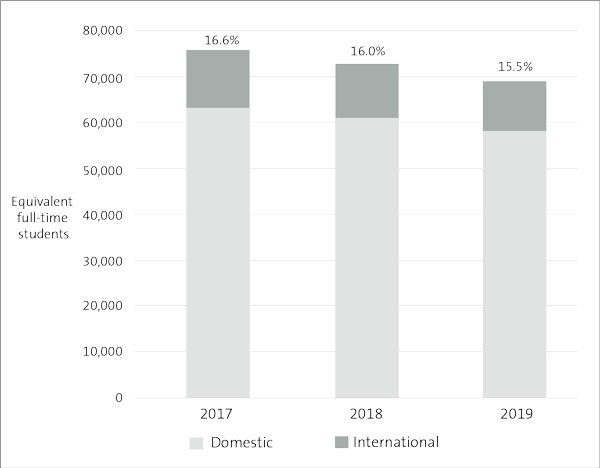Part 8: The institutes of technology and polytechnics and Te Pūkenga: 2019 to 2021
8.1
Since its establishment in April 2020, Te Pūkenga has been through a number of changes to its structure. For this reason, this section of our report discusses the financial results and enrolments of Te Pūkenga in the context of the changes that have happened over recent years.
Audit results for 2019
8.2
Before Te Pūkenga was established, 16 institutes of technology and polytechnics (ITPs) were in place and operated as independent TEIs. In 2020, we reported that total enrolments across the 16 ITPs had declined between 2017 and 2019 (see Figure 17).
Figure 17
Total full-time student enrolments and the percentage of international equivalent full-time students at institutes of technology and polytechnics, from 2017 to 2019

8.3
Total revenue also declined over this period, from $1.095 billion in 2017 to $1.056 billion in 2019 (see Figure 18).
Figure 18
Revenue for institutes of technology and polytechnics, from 2017 to 2019

Source: Data collected from ITPs' annual reports.
Audit results for 2020
8.4
The implementation of the reforms started in 2020. This included disestablishing the ITPs and creating a single entity – Te Pūkenga – that would integrate their functions. The intention was that Te Pūkenga would, over time, include the arranging training function that previously sat with the Industry Training Organisations.
8.5
On 1 April 2020, Te Pūkenga began operating and the 16 ITPs became its Crown entity subsidiaries.
8.6
The first quarter of 2020 also saw the closure of New Zealand's borders in response to Covid-19. This directly affected enrolments across the tertiary education sector, including at Te Pūkenga. Total EFTS went from 68,945 in 2019 to 66,235 in 2020.
8.7
The Government decided not to recover funding from tertiary education providers that under-delivered courses based on volume during 2020 due to the effects of Covid-19. This provided a buffer for TEIs against a worsening financial position, given the reduction in both domestic and international enrolments. For Te Pūkenga, this meant it did not have to return $57 million to TEC.
Audit results for 2021
8.8
It was a strong year for enrolments across the tertiary education sector in 2021. This was related to direct government support, closed borders, and the continued impact of Covid-19.40
8.9
There were also further changes at Te Pūkenga. A Crown entity subsidiary called Te Pūkenga – Work Based Learning Limited was created on 1 August. Its purpose was to help transition industry training learners into Te Pūkenga from the Transitional Industry Training Organisations.
8.10
Between August and November 2021, three Transitional Industry Training Organisations transitioned into Te Pūkenga – Work Based Learning Limited. They were:
- Competenz (on 2 August);
- Connexis (on 1 September); and
- BCITO (on 4 October).
8.11
Between August and October 2021, 21,352 Standard Training Measures were transferred to Te Pūkenga. Standard Training Measures are learners in work-based learning environments. This is in contrast to EFTS, which refers to learners in provider-based learning environments such as universities and wānanga.
8.12
Figure 19 shows the composition of learners at Te Pūkenga in its first two years of operation.
Figure 19
Equivalent full-time students and Standard Training Measures at Te Pūkenga, from 2020 to 2021

8.13
The increase in EFTS in 2020 and 2021 and inclusion of the industry training Standard Training Measures in 2021 affected the revenue for Te Pūkenga, which in 2021 was $1.17 billion. In the previous year it was $363 million. However, the low level of revenue in 2020 is largely related to the accounting implications associated with a nine-month period of operations.41
Conclusion
8.14
Te Pūkenga has experienced considerable change to its structure since it was established in 2020. Through this period of change, it has also been affected by the Covid-19 pandemic.
8.15
The Covid-19 pandemic has affected enrolment numbers at Te Pūkenga. This has meant additional government support has been required at times, as we saw in 2020.
8.16
We know that despite the significant increase to enrolments in 2021, the tertiary education sector experienced reduced demand in 2022. TEIs are experiencing pressure due to reduced enrolments and ongoing waves of illness. For Te Pūkenga, enrolments as at August 2022 had decreased by more than 17% compared to August 2021.
8.17
Fluctuating enrolment numbers are not new for TEIs. Because of this, a plan to ensure ongoing financial sustainability is vital for all TEIs, particularly Te Pūkenga.
8.18
We have previously noted our concerns at the lack of a detailed plan about how Te Pūkenga will address its underlying financial issues and the need for a sustainable financial plan for its future. We understand this work has been prioritised, and we look forward to seeing the final plan.
40: Tertiary Education Commission (2022), Pūrongo-ā-tau Annual Report for the year ended 30 June 2022, at tec.govt.nz.
41: This was for the nine-month period 1 April to 31 December 2020, and also reflects the fact that the revenue received by the previous institutes of technology and polytechnics for the full year was required by generally accepted accounting practice to be recognised by end of the first quarter, 31 March 2020 (the day they were disestablished).
